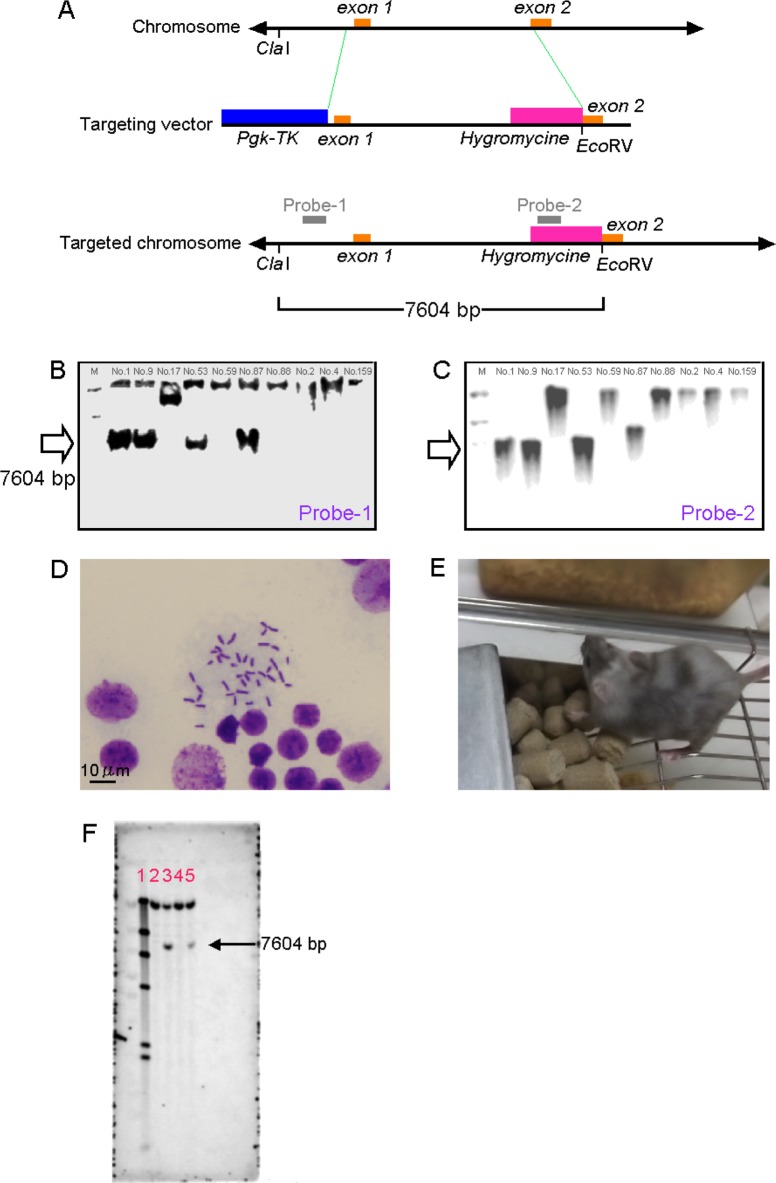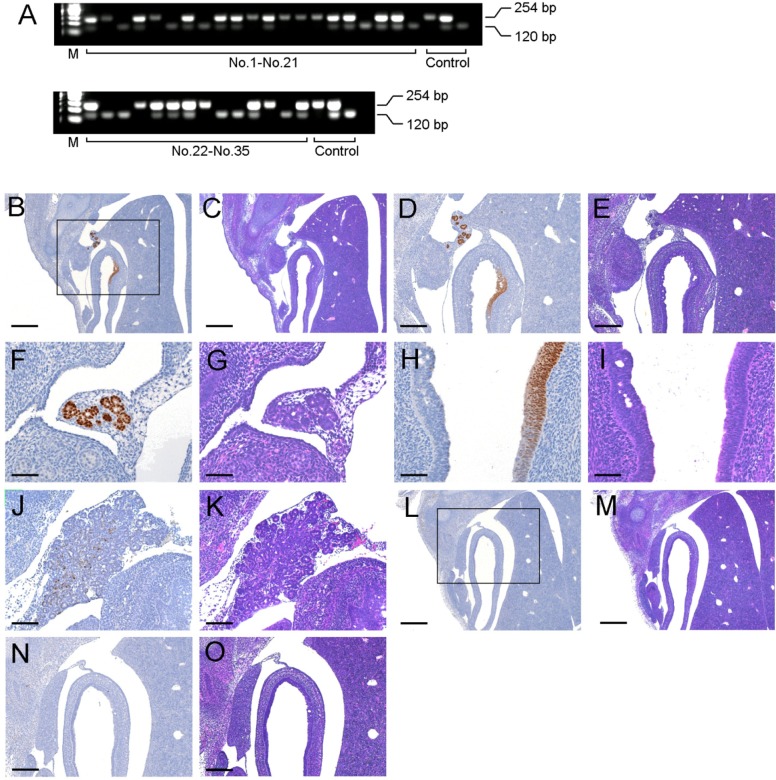Lab Anim Res.
2015 Jun;31(2):93-98. 10.5625/lar.2015.31.2.93.
Expression of pancreatic and duodenal homeobox1 (PDX1) protein in the interior and exterior regions of the intestine, revealed by development and analysis of Pdx1 knockout mice
- Affiliations
-
- 1Central Institute for Experimental Animals, Kawasaki-shi, Japan. hashimot@ciea.or.jp
- 2National Agriculture and Food Research Organization, Institute of Livestock and Grassland Science, Tsukuba, Japan.
- KMID: 2053683
- DOI: http://doi.org/10.5625/lar.2015.31.2.93
Abstract
- We developed pancreatic and duodenal homeobox1 (Pdx1) knockout mice to improve a compensatory hyperinsulinemia, which was induced by hyperplasia in the beta cells or Langerhans' islands, as the diabetic model mice. For targeting of Pdx1 gene by homologous recombination, ES cells derived from a 129(+Ter)/SvJclxC57BL/6JJcl hybrid mouse were electroporated and subjected to positive-negative selection with hygromycin B and ganciclovir. As these results, one of the three chimeric mice succeeded to produce the next or F1 generation. Then, the mouse fetuses were extracted from the mother's uterus and analyzed immunohistologically for the existence of a pancreas. The fetuses were analyzed at embryonic day 14.5 (E14.5) because Pdx1 knockout could not alive after birth in this study. Immunohistochemical staining revealed that 10 fetuses out of 26 did not have any PDX1 positive primordium of the pancreas and that the PDX1 expresses in both the interior and exterior regions of intestine. In particular, one the exterior of the intestine PDX1 was expressed in glands that would be expected to form the pancreas. The result of PCR genotyping with extracted DNA from the paraffin sections showed existence of 10 Pdx1-knockout mice and corresponded to results of immunostaining. Thus, we succeeded to establish a Pdx1-knockout (Pdx1-/-) mice.
Keyword
MeSH Terms
Figure
Reference
-
1. Wright CV, Schnegelsberg P, De Robertis EM. XlHbox 8: a novel Xenopus homeo protein restricted to a narrow band of endoderm. Development. 1989; 105(4):787–794. PMID: 2574662.
Article2. Ohlsson H, Karlsson K, Edlund T. IPF1, a homeodomain-containing transactivator of the insulin gene. EMBO J. 1993; 12(11):4251–4259. PMID: 7901001.
Article3. Leonard J, Peers B, Johnson T, Ferreri K, Lee S, Montminy MR. Characterization of somatostatin transactivating factor-1, a novel homeobox factor that stimulates somatostatin expression in pancreatic islet cells. Mol Endocrinol. 1993; 7(10):1275–1283. PMID: 7505393.
Article4. Miller CP, McGehee RE Jr, Habener JF. IDX-1: a new homeodomain transcription factor expressed in rat pancreatic islets and duodenum that transactivates the somatostatin gene. EMBO J. 1994; 13(5):1145–1156. PMID: 7907546.
Article5. Guz Y, Montminy MR, Stein R, Leonard J, Gamer LW, Wright CV, Teitelman G. Expression of murine STF-1, a putative insulin gene transcription factor, in beta cells of pancreas, duodenal epithelium and pancreatic exocrine and endocrine progenitors during ontogeny. Development. 1995; 121(1):11–18. PMID: 7867492.
Article6. Peshavaria M, Gamer L, Henderson E, Teitelman G, Wright CV, Stein R. XIHbox 8, an endoderm-specific Xenopus homeodomain protein, is closely related to a mammalian insulin gene transcription factor. Mol Endocrinol. 1994; 8(6):806–816. PMID: 7935494.
Article7. Hashimoto H, Arai T, Takeguchi A, Hioki K, Ohnishi Y, Kawai K, Ito M, Suzuki R, Yamauchi T, Ohsugi M, Saito M, Ueyama Y, Tobe K, Kadowaki T, Tamaoki N, Kosaka K. Ontogenetic characteristics of enzyme activities and plasma metabolites in C57BL/6J:Jcl mice deficient in insulin receptor substrate 2. Comp Med. 2006; 56(3):176–187. PMID: 16774126.8. Hashimoto H. Study on establishment of congenic strains and screening of characteristics in IRS-2 deficient mice to support translational research on type 2 diabetes. Exp Anim. 2011; 60(1):21–32. PMID: 21325749.
Article9. Hashimoto H, Arai T, Mori A, Kawai K, Hikishima K, Ohnishi Y, Eto T, Ito M, Hioki K, Suzuki R, Ohsugi M, Saito M, Ueyama Y, Okano H, Yamauchi T, Kubota N, Ueki K, Tobe K, Tamaoki N, Kadowaki T, Kosaka K. Reconsideration of insulin signals induced by improved laboratory animal diets, Japanese and American diets, in IRS-2 deficient mice. Exp Clin Endocrinol Diabetes. 2009; 117(10):577–586. PMID: 19629935.
Article10. Terauchi Y, Takamoto I, Kubota N, Matsui J, Suzuki R, Komeda K, Hara A, Toyoda Y, Miwa I, Aizawa S, Tsutsumi S, Tsubamoto Y, Hashimoto S, Eto K, Nakamura A, Noda M, Tobe K, Aburatani H, Nagai R, Kadowaki T. Glucokinase and IRS-2 are required for compensatory beta cell hyperplasia in response to high-fat diet-induced insulin resistance. J Clin Invest. 2007; 117(1):246–257. PMID: 17200721.11. Fukushima M, Suzuki H, Seino Y. Insulin secretion capacity in the development from normal glucose tolerance to type 2 diabetes. Diabetes Res Clin Pract. 2004; 66(Suppl 1):S37–S43. PMID: 15563978.
Article12. Butler AE, Janson J, Bonner-Weir S, Ritzel R, Rizza RA, Butler PC. Beta-cell deficit and increased beta-cell apoptosis in humans with type 2 diabetes. Diabetes. 2003; 52(1):102–110. PMID: 12502499.13. Brissova M, Shiota M, Nicholson WE, Gannon M, Knobel SM, Piston DW, Wright CV, Powers AC. Reduction in pancreatic transcription factor PDX-1 impairs glucose-stimulated insulin secretion. J Biol Chem. 2002; 277(13):11225–11232. PMID: 11781323.
Article14. Kobayashi T, Yamaguchi T, Hamanaka S, Kato-Itoh M, Yamazaki Y, Ibata M, Sato H, Lee YS, Usui J, Knisely AS, Hirabayashi M, Nakauchi H. Generation of rat pancreas in mouse by interspecific blastocyst injection of pluripotent stem cells. Cell. 2010; 142(5):787–799. PMID: 20813264.
Article15. Jonsson J, Carlsson L, Edlund T, Edlund H. Insulin-promoter-factor 1 is required for pancreas development in mice. Nature. 1994; 371(6498):606–609. PMID: 7935793.
Article16. Sugawara A, Goto K, Sotomaru Y, Sofuni T, Ito T. Current status of chromosomal abnormalities in mouse embryonic stem cell lines used in Japan. Comp Med. 2006; 56(1):31–34. PMID: 16521857.17. Offield MF, Jetton TL, Labosky PA, Ray M, Stein RW, Magnuson MA, Hogan BL, Wright CV. PDX-1 is required for pancreatic outgrowth and differentiation of the rostral duodenum. Development. 1996; 122(3):983–995. PMID: 8631275.
Article18. Ahlgren U, Jonsson J, Edlund H. The morphogenesis of the pancreatic mesenchyme is uncoupled from that of the pancreatic epithelium in IPF1/PDX1-deficient mice. Development. 1996; 122(5):1409–1416. PMID: 8625829.
Article19. Kanai-Azuma M, Kanai Y, Gad JM, Tajima Y, Taya C, Kurohmaru M, Sanai Y, Yonekawa H, Yazaki K, Tam PP, Hayashi Y. Depletion of definitive gut endoderm in Sox17-null mutant mice. Development. 2002; 129(10):2367–2379. PMID: 11973269.
Article20. Takahashi M, Ikemoto S, Ezaki O. Effect of the fat/carbohydrate ratio in the diet on obesity and oral glucose tolerance in C57BL/6J mice. J Nutr Sci Vitaminol (Tokyo). 1999; 45(5):583–593. PMID: 10683810.
Article21. Matschinsky FM. Banting Lecture 1995. A lesson in metabolic regulation inspired by the glucokinase glucose sensor paradigm. Diabetes. 1996; 45(2):223–241. PMID: 8549869.
Article
- Full Text Links
- Actions
-
Cited
- CITED
-
- Close
- Share
- Similar articles
-
- Generation of Insulin-Expressing Cells in Mouse Small Intestine by Pdx1, MafA, and BETA2/NeuroD
- Decreased Expression and Induced Nucleocytoplasmic Translocation of Pancreatic and Duodenal Homeobox 1 in INS-1 Cells Exposed to High Glucose and Palmitate
- Effect of Pdx1 Expression after Sox9 Depletion in the Early Pancreatic Development in African Clawed Frog (Xenopus laevis)
- Comparative Study of Two Common In Vitro Models for the Pancreatic Islet with MIN6
- Combination of Obestatin and Bone Marrow Mesenchymal Stem Cells Prevents Aggravation of Endocrine Pancreatic Damage in Type II Diabetic Rats



